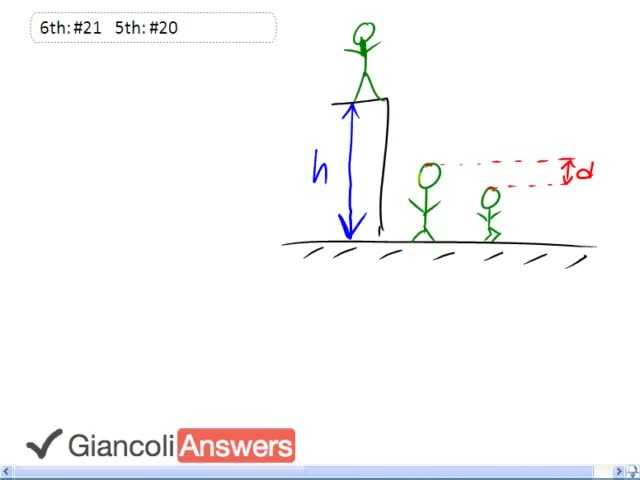

In order to watch this solution you need to have a subscription.
Our strategy for this question will be to calculate what speed will this person who jumps off a cliff have just before they hit the ground, and we’ll use conservation of energy to figure out that speed just before they hit the ground. The whole point of the question is to figure out what maximum height can they jump from so that they don’t break their leg, and their legs will be slowing them down over this distance that we’ll call ‘d’, zero point six meters. We have: one half ‘m’ times ‘v’ squared equals ‘m’ times ‘g’ times ‘h’, so the potential energy at the top of the cliff will equal the kinetic energy at the bottom of the cliff, so we’re calculating the speed just before they hit the ground. We solve that for ‘v’ by multiplying by multiplying both sides by two and dividing both sides by ‘m’ and we’ll take the square root of both sides: ‘v’ equals the square root of negative two times ‘g’ times ‘h’, we put a negative sign in front of that two if we want to use the conventional coordinate system of upwards being positive. That ‘v’ is the ‘v’ just before they hit the ground. Now we’re going to calculate how much time does it take for them to stop themselves, so how much time does it take to get from just before they hit the ground to their legs fully bent, so how much time does it take to move the distance ‘d’? So let’s the kinematics formula: ‘d’ equals average speed, ‘vi’ plus ‘vf’ over two, times time and then we’ll solve this for ‘t’, ‘t’ equals two times ‘d’ over ‘vi’ plus ‘vf’. The ‘vi’ is the square root of negative two times ‘g’ times ‘h’ for the purposes of this formula and ‘vf’ is zero because the person stops themselves with their legs. The force formula is: change in momentum over change in time, so our strategy is now that we’ve calculated how much time it takes for them to bend their legs we can also figure out what the change in momentum is and that’s how we’re going to find the force, and then knowing the force we can say what maximum height can the jump from. So we have ‘m’ times ‘vf’ minus ‘m’ times ‘vi’, that’s the impulse or the change in momentum, divided by ‘t’. ‘vf’ is zero so we have: negative times negative ‘m’ times the square root of two times ‘g’ times ‘h’ divided by ‘t’ which is equal to ‘m’ times the square root of two times ‘g’ times ‘h’ divided by two times ‘d’ over ‘vi’. So that’s: ‘m’ times the square root of two times ‘g’ times ‘h’ times ‘vi’ over two times ‘d’, simplifying and substituting for ‘vi’: ‘m’ times the square root of two times ‘g’ times ‘h’ times negative ‘m’ times the square root of two times ‘g’ times ‘h’ divided by two times ‘d’ which works out to negative two times ‘m’ times ‘g’ times ‘h’ over two times ‘d’ which is negative ‘m’ times ‘g’ times ‘h’ over ‘d’. So we have that the force exerted by the legs is negative ‘m’ times ‘g’ times ‘h’ over ‘d’, where ‘h’ is the height of the cliff, and ‘d’ is the distance the person bends their legs. We need to solve this for ‘h’ because that’s the whole question, so we’ll multiply both sides by ‘d’ and we’ll divide both sides by ‘m’ times ‘g’ giving us: ‘h’ is negative ‘F’ times ‘d’ divided by ‘m’ times ‘g’. We’re give some estimates on the force capacity of human legs and we’re told that they can exert a force of one hundred and seventy times ten raised to power six newtons per square meter and the area of a leg bone is two point five times ten raised to power negative four meters squared, so it gives us a total force from one leg of forty two thousand five hundred newtons. Since this is from one leg only we can actually multiply this by two to get the total force that’s possible, so ‘Ftotal’ from both legs is going to be two times forty two thousand five hundred which is eighty five thousand newtons. This is the number we’re going to substitute in our formula for ‘h’: ‘h’ is negative ‘F’ times ‘d’ over ‘m’ times ‘g’, so that’s negative eighty five thousand newtons times negative zero point six zero meters, it’s negative because it’s directed downwards, divided by seventy five kilograms times nine point eight meters per second squared and this give us a maximum height of the cliff without breaking a bone of sixty nine meters.